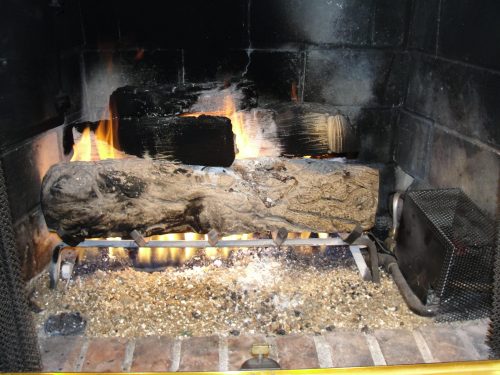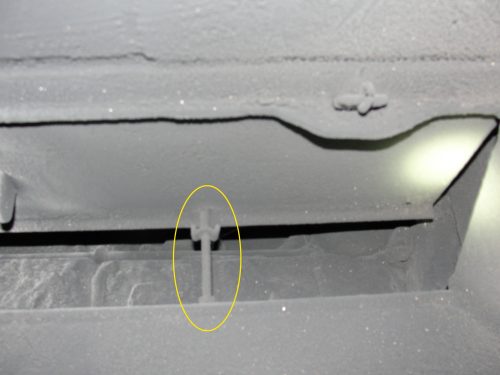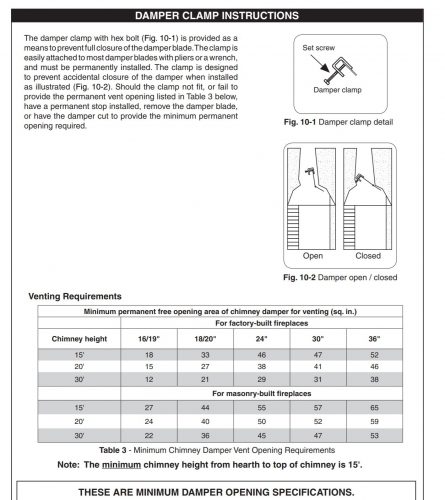I’m not a fan of gas log fireplaces because they waste energy and they’re a potential safety hazard. These fireplaces start out as wood-burning fireplaces, but at some point, someone decides that building a wood fire is too much work and artificial firelogs are ugly, so they have a gas log installed.
Most gas logs are pretty simple; they basically consist of a pipe with a bunch of holes, and some fake logs stacked on top. Gas comes out of the holes, the gas burns, and the exhaust gases go up the chimney, just like when you build a fire.
Before I get too far into this discussion, however, we should dig into a few definitions.
- Gas log: uses the existing fireplace… everything. The firebox, damper, flue, everything. You’re just changing the fuel type from wood to gas. You can roast marshmallows right over the flames. This is also known as a Decorative Appliance for Installation in a Fireplace, and you can find the installation rules under section 602 of the Minnesota Fuel Gas Code. I’ll admit, this is about as close as you’ll get to a wood fire without actually burning wood.
- Gas insert: a whole system installed in a masonry fireplace opening. It’ll have its own enclosure, vent liner, glass front, all that jazz. There are two types of gas inserts; one is listed under ANSI Z21.80 as a heat source. The other type is listed under ANSI Z21.50 as a decorative appliance only. You can’t tell the difference between the two without reading the listing tag inside of the unit. I’ve asked numerous fireplace experts about the difference between these two fireplaces, and their answer is always “the ANSI standard.” Very funny.
- Gas fireplace: a standalone appliance. You might find it installed on an outside wall, an inside wall, freestanding, whatever. It won’t have anything to do with a traditional fireplace. These can also be listed as a heat source or not.
What happens if the damper is closed? If the fireplace damper is closed when a gas log fireplace is operated, the combustion gases will come right into the house. While you have the same potential for this to happen with a wood-burning fireplace, it will be quite obvious if a wood-burning fire exhausts into the house; everything is going to get very smoky, very quickly.
When the combustion gases from a gas log fireplace come back into the house, it’s not nearly as obvious; in fact, it could be very easy to miss. These gases can contain high levels of carbon monoxide, making this a safety hazard.
Damper clips are supposed to fix this issue. To make sure the damper never gets completely closed on a gas log fireplace, there must be a damper clip installed. This will be required by the ANSI Standard that the gas log is built to, ANSI Z21.60. This damper clip will prevent the damper from closing all the way and is supposed to prevent the exhaust gases from coming back into the house.
I’ve tested several damper clips to see just how effective they are, and most don’t do their job. These damper clips usually allow the damper to close most of the way. When the damper is mostly closed, most of the exhaust gases will still come back into the home. To work properly, a damper clip needs to keep the damper open all the way, or at least most of the way.
In my humble opinion, the installation instructions that come with these gas logs are nearly impossible to follow. Take a look at the example below, and click on it to get a bigger, readable version:
Does anyone honestly believe the installer is going to read these instructions, much less determine the correct row and column, and then calculate the net square inches? NO WAY. They’re going to put the damper clip in place and call it done, or they’re going to do the safe thing and remove the damper entirely. But that’s not a great option either.
When the damper is removed or locked fully open, there will always be warm air leaving the house through the chimney, cold air coming into the house through the chimney, or both. This is a major source of energy loss. Yet the damper should be fully open when the gas log is operated. Oh, and you’re also required to have a screen present anytime the gas log is operating. I’ll go on record by saying that nobody has ever done this.
My recommendation: Don’t install a gas log in your fireplace. If you already have a gas log, consider upgrading it to a newer direct-vent gas insert. These have a two-pipe system, which allows them to bring in air directly from the exterior for combustion, instead of using the air in the home. They kick out a lot of heat, especially if there is a blower fan installed. They’re safer, and you won’t be wasting heat all year. If they’re built to ANSI Z21.88, they can even be counted as a heat source. I have one in my basement living room, and that thing gets used a ton. The whole family loves it, and there’s no safety penalty or energy penalty to pay.
For a longer discussion about gas log fireplaces, please check out our podcast from yesterday on the topic:




Belinda Irwin
October 21, 2021, 1:12 am
Would you recommend gas log insert if only being used occasionally for ambiance and not all the time as a heat source?
Reuben Saltzman
October 21, 2021, 6:33 am
Hi Belinda, yes, definitely. There are actually two categories of gas fireplaces. One type is listed to be used as a heat source, and the other as a decorative gas appliance.
Laura
November 5, 2021, 5:08 pm
Is t safe to say you have a high opinion of ventless propane gas fire logs? My fireplace is dual sided solely made for ventless I’m slightly terrified.
Reuben Saltzman
November 6, 2021, 6:10 am
Hi Laura, ventless gas appliances are not allowed here in Minnesota. There is an increased risk of carbon monoxide entering the home, but more importantly, all of these appliances generate large amounts of moisture which get added to the home, which can lead to mold and other moisture-related problems in a home.
Corey
November 8, 2021, 6:46 am
I’m a 3rd generation chimney sweep and I 100% agree that gas logs are often a horrible option. Nonvent are even worse! The old school thinking was “The fireplace isn’t safe for wood burning. How about we throw gas logs into it”. The problem is that in the instructions, gas logs must be installed into a fireplace that meets all minimum requirements for burning wood. Gas actually burns hotter, so the clearances and requirements are even more important than for wood. There are many requirements that un-certified chimney sweeps glance over such as wood supporting the hearth extension, combustible trim too close to the opening of the fireplace, the flue liner not being in good shape with cracks or gaps, and even wood underneath the firebox floor gets missed. These are all things that can and do cause structure fires.
Thank you for suggesting d/v inserts. That is usually our go to for when someone wants to burn gas. They have wildly stringent requirements as well so you have to read the instructions.